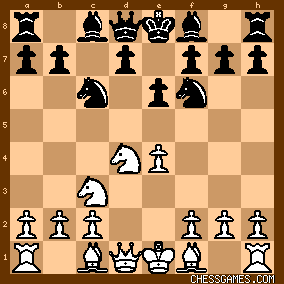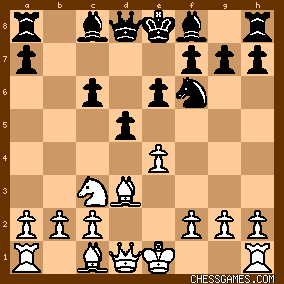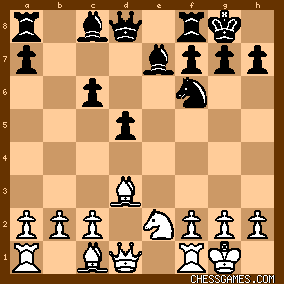| KEG: The 32nd and last game in the long rivalry between Blackburne and Mason. Blackburne's fine win here brought the final tally between these two veterans to 15 to 7 with 10 draws in Blackburne's favor. This game was fairly one-sided. Mason dropped a pawn on move 14 (missing a neat tactical finesse by Blackburne) and then erred badly on his 25th turn allowing Blackburne to unleash one of his glorious combinations. As jdc2 has pointed out on this site, Blackburne's combo here appears in one of Reinfeld's books on tactics. Blackburne was no longer a major factor at international tournaments at this stage of his career (he finished with a respectable 6.5 out of 13 at Monte Carlo 1901). But he was still a dangerous tactician. Lasker lost only two games in total in crushing the field at both London 1899 and Paris 1900. One of these was to Blackburne at London 1899 as the result of a spectacular sacrifice that even Lasker overlooked (Lasker's other loss in this period was to Marshall at Paris 1900). Incidentally, most of the notes appearing in the Tournament Book for this game were by "Sittenfeld." I have no idea who he was. 1. e4 c5
2. Nf3 Nc6
3. d4 cxd4
4. Nxd4 Nf6
5. Nc3 e6

click for larger view6. NxN
"This move strengthens the Black pawn centre and is not the best. I prefer 6. Be3." (Tournament Book). "The strongest is 6. Ndb5." (Schlechter).
While the moves suggested by the Tournament Book and (especially) the one by Schlechter) are good options, there is nothing wrong with the text, which has been played by Kasparov (at least three times), Lasker (at least three times), Marshall, Najdorf, Robert Byrne, Spassky, Short, Timman, Anand, Akopian, Karjakin and a host of other fine players. The move derives from an 1849 game between Bird and Medley. It appears to yield White a tiny edge. 6... bxN
7. Bd3
The Tournament Book called this "weak" and suggested 7. e5. Both moves have their points. I prefer the text, which does not invite 7...Nd5. 7... d5!
Announcing his intention to fight for the initiative and to play for a win. 7...Bd6 was a good, safe alternative. 
click for larger view8. exd5
Giving up the center without a fight and handing the advantage to Black. The Tournament Book's suggested 8. Qe2 was certainly better. Best of all, however, was the simple 8. 0-0. 8... exd5
8...cxd5 keeping his pawn chair intact (and avoiding a backward c-pawn) was probably the sounder approach but not in Blackburne's style. The text was the way to unleash the c8 Bishop for attack, and I would not have expected anything else from Blackburne in such a position. 9. 0-0 Be7
9...Bd6 looks stronger.
10. Ne2
Obviously intending Ng3-f5 (or h5). But 10. Bf4 or 10. Re1 (and perhaps 10. h3) look more solid. 10... 0-0

click for larger view11. Ng3
This attacking scheme was premature. Mason could better have taken on Blackburne's dangerous looking center with 11. c4, or perhaps gotten his c1 Bishop into play beginning with 11. b3. 11... Qc7
11...Bd6 still looks stronger.
12. c3
"He ought to continue with the plan of Nf5 to be followed by Bg5." (Tournament Book). 12. Nf5 would run into 12...BxN 13. BxB Rfe8 giving Black the better chances. The text, however, is no prize either. Better was 12. b3 or 12. c4. After the text, as the Tournament Book notes, Blackburne assumed the initiative. 12... Ng4
"!"--(Tournament Book)
Also good were 12...Bd6 or 12...Re8. In any case, the initiative had indeed passed to Blackburne, the position after 12...Ng4 being: 
click for larger view | 




